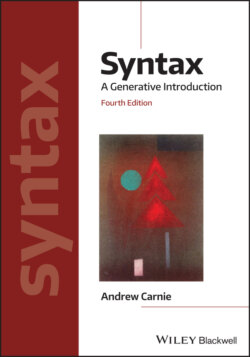Читать книгу Syntax - Andrew Carnie - Страница 37
4. SUBCATEGORIES AND FEATURES
ОглавлениеYou may have noticed that in sections 2 and 3, I hinted that each major part of speech category may have subtypes. For example, we listed six different kinds of D (articles, deictics, quantifiers, numerals, possessive pronouns, wh-pronouns) and three kinds of T (auxiliaries, modals, and the non-finite marker). The technical term for these subtypes is subcategories. For the most part, we are going to be interested in the main part of speech categories (N, V, Adj, Adv, P, D, Conj, C, T, and Neg), but sometimes we will want to refer to the subcategories.
One way to mark subcategories is through the use of features. Consider the case of
T. To distinguish among the subcategories we can appeal to the features [±MODAL] and [±FINITE]:
17) Auxiliary 8 T[–MODAL, +FINITE]
Modal T[+MODAL, +FINITE]
to T[+MODAL, -FINITE]
One set of possible values of these features is missing ([-MODAL, -FINITE]). We might similarly distinguish among tense forms using features like [±PAST] etc. So was is [+PAST]; is is [-PAST] etc.
Similarly we can distinguish among the various kinds of determiner using features like [±WH], [±QUANTIFIER], [±DEICTIC], etc. The details of this kind of analysis aren’t crucial to the grammar fragments you are given in this book, as long as you understand the basic concept behind using features to mark subcategories.9 In the rest of this section,
we look at some of the subcategories of N, V, and P that will be of use to us in the rest of the book.
I’m not going to discuss subcategories of Adj and Adv, although they exist. In a grey textbox above, I’ve suggested that Adj and Adv are themselves subcategories of a larger category A. We also find many subcategories within the Adj and Adv categories. Some of these distinctions are explored in problem sets at the end of the chapter.
4.1 Subcategories of Nouns
We can slice the pie of English nouns apart along several dimensions including plural vs. singular, proper vs. common, pronoun vs. lexical noun, and count vs. mass noun.
First, let’s distinguish along the line of plurality. English nouns can be either singular or plural. The distinction between singular and plural is usually morphologically marked with one of the plural endings like -s or -es (although it need not be, as in mice or deer). Most singular nouns in English require a D;10 plural ones do not require a D, although they allow one:
18)
1 *Cat ate the spider.
2 The cat ate the spider.
3 Cats ate the spider.
4 The cats ate the spider.
We mark this distinction with the feature [±PLURAL].
Closely related to the plural/singular distinction is the count vs. mass noun distinction. Count nouns represent individual, “countable” elements. For example, apple is a count noun. “Mass nouns” usually can’t be counted in the same way. For example sincerity and air are mass nouns. There are two easy distributional tests to distinguish between mass and count nouns. Mass nouns take the quantifier much, while count nouns take many.
19)
1 many apples
2 *much apples/apple11
3 *many sincerity
4 *many air
5 much sincerity
6 much air
Like plurals, mass nouns generally don’t require a determiner, but count nouns do:
20)
1 *I ate apple.
2 I ate the apple.
3 I ate sugar.
4 I ate the sugar.
5 She is filled with sincerity.
6 I doubt her sincerity.
We distinguish between count and mass nouns using the feature [±COUNT].
Next, let us distinguish between proper names and common nouns. Proper names are nouns like Andrew Carnie. Common nouns are all other nouns. For the most part, proper names resist taking determiners:
21) a) Andrew Carnie
b) *the Andrew Carnie
There are some exceptions to this generalization. For example, when referring to a family it’s common to say the Smiths. In other languages, proper names can take determiners. For example, in some dialects of Spanish, it is okay to say La Rosamaria “the Rosemary”. If necessary, we can distinguish proper names from common nouns using the feature [±PROPER], although this feature is less useful than the others.
Finally let’s look at the subcategories of pronouns and anaphors. These classes differ from the others in that they are closed. They never allow determiners or adjectival modification.
| 22) a) | he | b) | himself |
| c) | *the he | d) | *the himself |
| e) | *big he | f) | *big himself |
Pronouns belong to the class [+PRONOUN, –ANAPHOR]. Anaphors are [+PRONOUN,
+ANAPHOR]. All other nouns are [–PRONOUN, –ANAPHOR].
You now have enough information to do WBE 11-13 and GPS 11.
